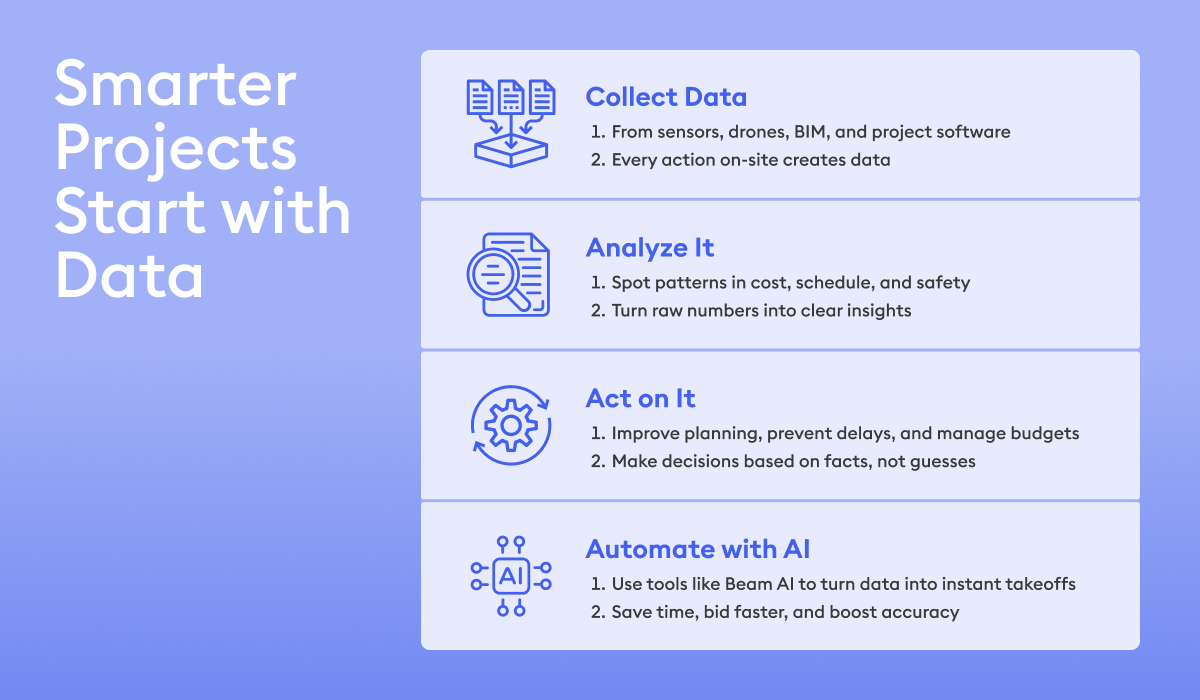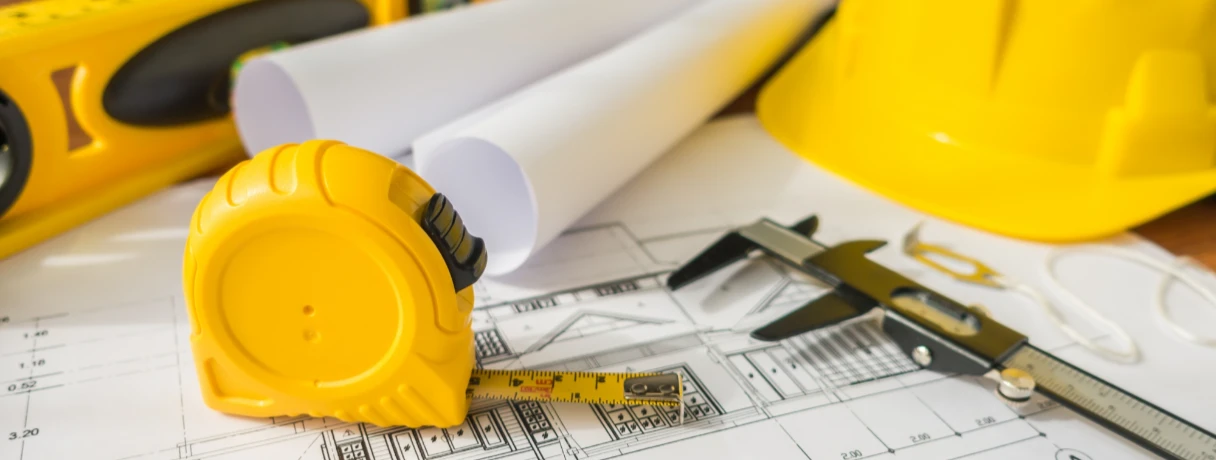Data analytics in construction helps teams move from guesswork to clear, data-backed decisions. It improves project planning, safety, and profits—turning information into real action on-site and off.
What Is Data Analytics in Construction?
Think of data analytics in construction as turning thousands of scattered project details—schedules, costs, materials, labor hours—into clear insights that guide smarter decisions.
It’s the process of collecting, analyzing, and using data from multiple sources like sensors, project management tools, BIM models, and even drones to understand what’s really happening across your projects.
From Raw Data to Actionable Insights
On a typical job site, there’s tons of raw data: weather logs, crew productivity, equipment use, material delivery times. When analyzed, these data points reveal patterns—like which teams finish tasks faster or what conditions delay pours.
The result? You stop relying on instinct and start planning based on facts.
Key Benefits of Data Analytics in Construction
So, why does data analytics matter so much for construction professionals? Let’s break it down.

Enhanced Decision-Making & Strategic Planning
Data analytics gives project managers a clear view of every moving part. With dashboards showing real-time performance, you can make faster, smarter decisions—like when to adjust schedules, order materials, or reassign crews.
Boosting Project Efficiency & Productivity
By tracking data on resource usage and task durations, managers can spot inefficiencies. Maybe a certain crew consistently finishes early. Maybe equipment downtime spikes midweek. These insights help you schedule better and use resources wisely.
When paired with AI-based takeoff tools like Beam AI, estimators also save hours on manual work. Beam AI turns project drawings into accurate material quantities within minutes—helping estimators focus on analysis, not measurement.
Cost Reduction & Profitability Optimization
Big data in construction exposes where money leaks—extra rework, unused inventory, or idle machines. Once you know what’s draining profit, you can fix it.
Improving Safety & Risk Management
Safety data from IoT sensors, wearables, and site reports help identify accident-prone zones or unsafe work patterns. This allows safety officers to act before incidents occur.
For example, wearable sensors can alert supervisors when workers enter high-risk zones or exceed safe fatigue limits.
Quality Control & Performance Monitoring
Analytics tools can track project quality indicators—like inspection results, defect rates, and equipment calibration logs.
When these data points are visualized, they highlight patterns that would otherwise go unnoticed. Quality control becomes proactive instead of reactive.
Practical Applications: Where Data Analytics Makes a Difference
Let’s look at some real-world use cases that show why analytics is transforming the way construction teams operate.
Accurate Quantity Takeoffs & Material Estimation
Estimators often struggle with manual takeoffs and material calculations. Using AI-driven platforms like Beam AI, construction teams can automate takeoffs from digital plans with up to 90% time savings. This ensures accurate bids, better cost forecasting, and fewer errors.
Project Schedule Optimization & Delay Prediction
Predictive analytics can analyze project schedules and flag activities likely to delay the project—based on weather, crew availability, or historical patterns.
It’s like having a warning system that tells you where trouble might start.
Predictive Maintenance for Equipment
Sensors on heavy machinery track usage, fuel, and wear. When data shows a drop in efficiency, maintenance can be scheduled before a breakdown happens. That keeps projects on schedule and reduces repair costs.
Resource Allocation & Supply Chain Management
Tracking data across sites helps managers see which equipment or materials are underused or overstocked. They can then reallocate resources where they’re needed most, saving time and reducing waste.
Budget Tracking & Cost Overrun Prevention
By combining data from accounting systems, ERP tools, and field reports, analytics platforms can track budgets in real time. You’ll spot overruns early, not after it’s too late.
Site Monitoring & Progress Tracking
Drones and 3D scanning tools capture daily site progress. Data from these scans helps project teams verify whether actual work matches the plan—making site progress measurable, not subjective.
Sources of Construction Data
To make data analytics work, you first need reliable data. Here are the most common sources used across US construction projects:
IoT Sensors, Drones & Wearables
- IoT sensors track temperature, vibration, and location.
- Drones capture aerial photos for mapping and monitoring.
- Wearables measure worker safety, movement, and fatigue.
Project Management Software & BIM
- Project management tools log daily reports, timelines, and issues.
- BIM models store rich design data that helps detect clashes and estimate quantities.
Historical Project Data & ERP Systems
- Past project reports, schedules, and costs offer benchmarks for new jobs.
- ERP systems combine finance, procurement, and HR data for a complete view of company performance.
The magic happens when all these sources connect, creating a single data ecosystem that everyone—from estimators to executives—can use.
Challenges and the Future of Data-Driven Construction
Overcoming Adoption Barriers
Many construction firms know the value of analytics but hesitate due to cost, training needs, or scattered data systems. The key is to start small—collect consistent data from ongoing projects and use tools that make insights easy to access.
Leadership buy-in is critical too. When decision-makers see how analytics improves margins and productivity, adoption spreads fast.
The Road Ahead: AI, Machine Learning, and Real-Time Analytics
The next wave of construction innovation lies in AI and real-time analytics.
AI tools are already transforming estimating, scheduling, and safety management.
For example, Beam AI combines automation and intelligence to process digital drawings and deliver instant takeoffs. This turns data into usable insights for estimators—helping them send out 2X more bids with the same team.
Machine learning algorithms will soon predict material shortages, forecast delays, and even recommend schedule tweaks automatically.
The future of construction isn’t just about building faster—it’s about building smarter.
Conclusion: Building Smarter with Data
The construction industry has always relied on experience, intuition, and teamwork. But experience gets stronger when backed by data.
By embracing data analytics in construction, companies can plan better, spend wiser, and deliver projects that meet deadlines and budgets more consistently.
From safety and efficiency to profit margins, data touches.
Tools like Beam AI show how analytics is no longer a “nice-to-have”—it’s the backbone of modern preconstruction and estimating. When data drives every step—from takeoff to turnover—results speak for themselves: faster decisions, fewer surprises, and stronger bids.
So the next time you’re starting a project, don’t just rely on instinct.
Let the data do the talking—and see how much smarter your projects can get.

.png)







.webp)




.webp)

